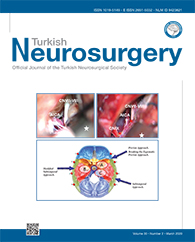2Baskent University, Department of Neurosurgery, Ankara, Turkey DOI : 10.5137/1019-5149.JTN.27735-19.2 AIM: To evaluate the relationship between trigeminal neuralgia (TN) and potential magnetic resonance imaging (MRI)-related measurements in patients with TN.
MATERIAL and METHODS: Retrospective analysis of 104 patients with TN was performed. MRI studies of 98 healthy controls were included in the study to compare the parameters with TN patientsâ measurements. MRI measurements of cerebellopontine cistern (CPC) cross-sectional area, trigeminal-pontine angle (TPA) width, and trigeminal nerve cisternal segment length and thickness were assessed on both symptomatic and asymptomatic sides using 1.5T MRI with constructive interference in steady-state sequences. The images were interpreted by two radiologists blinded to the affected sides of the patients.
RESULTS: There were significant differences between the symptomatic and asymptomatic sides in terms of mean trigeminal nerve length (8.8 ± 2.34 mm vs. 9.39 ± 2.29 mm; respectively, p=0.001) and thickness (20.9 ± 9.6 mm2 vs. 25 ± 9.98 mm2, respectively; p<0.001). The median cerebellopontine cistern cross-sectional area was considerably lower on the symptomatic side compared with the asymptomatic side [201 mm2 (interquartile range=93) vs. 224.5 mm2 (interquartile range=77), respectively; p<0.001]. There were no significant differences between the trigeminal-pontine angle width on either side (38.32 ± 10.38 vs. 38.78 ± 10.9, respectively; p=0.679). There were no statistically significant differences between the right and left sides regarding these parameters in the control group.
CONCLUSION: Smaller CPC cross-sectional area, trigeminal nerve length, and trigeminal nerve thickness on MRI were demonstrated to commonly exist on the symptomatic side in patients with TN. We suggest that this narrow space may increase the risk of vascular compression on the nerve.
Keywords : Trigeminal neuralgia, Trigeminal nerve length, Trigeminopontine angle, Cerebellopontine cistern, Magnetic resonance imaging




